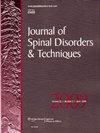Anterior Cervical Decompression and Fusion Versus Cervical Disk Arthroplasty.
Q Medicine
引用次数: 0
Abstract
Anterior cervical discectomy and fusion (ACDF) has been successfully used for over 50 years and is considered the standard of care for the treatment of anterior cervical stenosis resulting in cervical radiculopathy or myelopathy. Although ACDF has been shown to be a safe and effective procedure, nontrivial rates of adjacent segment degeneration (ASD) can lead to a need for revision surgery on the caudad or the cephalad levels. ASD necessitating revision surgery after an ACDF occurs at approximately a 2.9% per year rate during the first 10 years after the operation.1 In response to the development of ASD, cervical disk replacement (CDR) was developed to minimize ASD by maintaining motion and thus removing the mechanical impact of fusion on the adjacent disk spaces. The impact of fusion on ASD has been studied extensively. Several studies have shown that patients who underwent foraminotomy without fusion also developed ASD at relatively similar rates to those reported for patients with ACDF, suggesting that mechanical stress related to fusion is not likely to be the causal factor in the development of ASD. Further, Hilibrand et al1 showed a decreased rate of ASD in multilevel ACDFs compared with single-level ACDFs, suggesting that by fusing the “at-risk” levels they were able to avoid ASD. If a mechanical cause was to blame for ASD, we would expect to see increased ASD in patients with longer fused segments and more motion and stress placed on the cranial and caudal disks. Reitman et al4 provided further evidence against this mechanical theory of ASD in an in vivo study. They found no statistical difference in preoperative versus postoperative motion at adjacent segments after ACDF at 10 months. With the advent of CDR, many randomized studies have been performed to compare disk replacement with ACDF (Table 1). These studies have focused on patientreported outcomes using the Neck Disability Index (NDI), Short Form Health Survey (SF-36), and Visual Analog Scale (VAS) scales, and few have analyzed ASD specifically. Harrod and colleagues analyzed the available evidence of the rates of radiographic evidence of adjacent segment pathology and clinical adjacent segment pathology in 2012. They concluded that there was moderate evidence to support no difference in the rates of radiographic evidence of adjacent segment pathology or clinical adjacent segment pathology at the short-term and mid-term time follow-up periods between the uses of CDR and ACDF.5 Verma and colleagues performed a meta-analysis of prospective randomized studies comparing ACDF to CDR and found no statistically significant difference in the rates of adjacent segment disease (ASDI) between the 2 groups. There were 777 patients in the ACDF group, 36 of which required surgery to address ASD, and 809 in the CDR group, 30 of which required surgery to address ASD. Boselie and colleagues performed a Cochrane Systematic Review of the literature comparing CDR versus ACDF. They found that CDR had multiple metrics that were statistically more favorable than ACDF, but the clinical difference between the 2 was minimal. They also showed that ASD prevalence was not different between the 2 treatment modalities. They recommended that future studies comparing CDR with ACDF should focus on the development of ASD and revision surgeries. They also mentioned that without data on the lifespan of CDR, caution should be used in recommending it as the standard of care.7 Alvin et al8 conducted a meta-analysis of randomized controlled trials and stratified them according to time period performed and risk of conflict of interest (COI) in reporting their findings.8 They distinguished radiographic evidence of adjacent segment degeneration (ASD) from clinically impactful symptoms of adjacent segment disease (ASDI). Both treatment modalities showed significant improvements in NDI and VAS scores. When reported complication rates were examined, they showed that Received for publication June 24, 2015; accepted August 27, 2015. From the *Department of Orthopaedic Surgery, University of Utah, Salt Lake City, UT; wOrthoCarolina; and zOrthoCarolina Spine Center, Charlotte, NC. The authors declare no conflict of interest. Reprints: Iain S. Elliott, MD, Department of Orthopaedic Surgery, University of Utah, 590 Wakara Way, Salt Lake City, UT 84108 (e-mail: iain.elliott@hsc.utah.edu). Copyright r 2015 Wolters Kluwer Health, Inc. All rights reserved. CONTROVERSIES IN SPINE SURGERY颈椎前路减压融合与颈椎椎间盘置换术。
本文章由计算机程序翻译,如有差异,请以英文原文为准。
求助全文
约1分钟内获得全文
求助全文
来源期刊
CiteScore
2.16
自引率
0.00%
发文量
0
审稿时长
3 months
期刊介绍:
Journal of Spinal Disorders & Techniques features peer-reviewed original articles on diagnosis, management, and surgery for spinal problems. Topics include degenerative disorders, spinal trauma, diagnostic anesthetic blocks, metastatic tumor spinal replacements, management of pain syndromes, and the use of imaging techniques in evaluating lumbar spine disorder. The journal also presents thoroughly documented case reports.

 求助内容:
求助内容: 应助结果提醒方式:
应助结果提醒方式:


